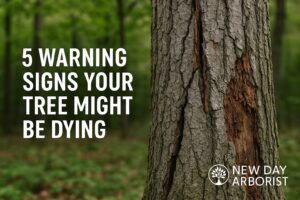 At New Day Arborist, we believe every tree tells a story—sometimes that story is one of strength and beauty, and sometimes it’s a quiet call for help. Trees are resilient, but like all living things, they can succumb to age, disease, pests, or environmental stress. The good news? Catching the warning signs early can make the difference between saving a cherished tree or facing its removal.
At New Day Arborist, we believe every tree tells a story—sometimes that story is one of strength and beauty, and sometimes it’s a quiet call for help. Trees are resilient, but like all living things, they can succumb to age, disease, pests, or environmental stress. The good news? Catching the warning signs early can make the difference between saving a cherished tree or facing its removal.
If you’re wondering whether that tree in your yard is struggling, here are five clear signs it may be dying—plus what you can do about it.
1. Visible Cracks or Splits in the Trunk
Cracks and splits in a tree trunk are more than cosmetic flaws—they’re structural red flags. These may appear vertically along the bark or around branch unions and can weaken the tree’s integrity.
What It Means:
-
Cracks can signal internal decay or previous storm damage.
-
If deep enough, they can split the trunk, making the tree prone to collapse in strong winds.
What You Should Do:
Call a certified arborist to inspect the tree. In some cases, cracks can be stabilized or pruned around. In others, removal may be the safest option—especially if the tree poses a risk to your home or pathways.
2. Dead or Falling Branches
Dead branches may not seem like a big deal, especially if they’re high up—but they’re one of the most common symptoms of tree distress.
What It Means:
-
Trees “shed” dying limbs to conserve resources, especially during drought or disease.
-
Repeated limb drop from the canopy may indicate the tree is in decline or suffering from root damage, fungal infections, or borer infestations.
What You Should Do:
If you see a branch that’s dry, brittle, and bare (even in spring or summer), get it checked. Pruning dead limbs early can prevent falling hazards and stop infections from spreading further into the tree.
3. Discolored or Peeling Bark
A healthy tree has vibrant, firmly attached bark. When bark starts flaking off, looks patchy, or changes color significantly, it’s time to take notice.
What It Means:
-
Peeling or missing bark may indicate disease, sunscald, or internal rot.
-
Discoloration can be a sign of fungal infection, such as cankers or blight.
What You Should Do:
Do not attempt to peel or scrape the bark yourself. Instead, schedule a consultation. An arborist can determine whether the issue is superficial or signals a deeper problem within the tree’s vascular system.
4. Leaf Problems: Discoloration, Wilting, or Thinning Canopy
Leaves are a tree’s most obvious sign of health. When they’re not behaving as they should, something is wrong.
Watch for:
-
Yellowing or browning leaves during the growing season
-
Wilting, even when the tree is getting water
-
A sparse canopy or small, underdeveloped leaves
What It Might Mean:
-
Nutrient deficiencies, pest infestations, or root issues
-
Fungal diseases such as anthracnose, verticillium wilt, or leaf spot
What You Should Do:
Take a photo and document when the leaf changes occur. This will help an arborist identify whether it’s a seasonal issue, a treatable disease, or something more serious.
5. Mushrooms or Fungus Growing at the Base
Mushrooms may look charming, but when they’re growing at the base of a tree or along the trunk, it’s a serious concern.
What It Means:
-
Fungi often signal internal decay.
-
Species like Armillaria (honey fungus) or Ganoderma attack the roots and can rot the tree from the inside out.
What You Should Do:
Never ignore fungal growth at the base. It often means the tree has compromised structural integrity and may fail unexpectedly. An arborist can identify the fungus type and assess whether the tree can be saved—or if it poses a safety hazard.
So, Can a Dying Tree Be Saved?
Sometimes, yes! If caught early, many of these problems can be treated through proper pruning, fertilization, or pest and disease management. However, not all trees can (or should) be saved—especially if they pose a risk to people, structures, or other healthy trees nearby.
At New Day Arborist, we always aim to preserve trees when it’s safe and reasonable. We start with a thorough inspection and provide honest, expert recommendations based on the tree’s condition and your property’s safety.
When in Doubt, Call a Pro 🌳
It’s easy to overlook subtle changes in your trees, especially when life gets busy. But the cost of ignoring early warning signs can be high—not just in potential tree removal costs, but in property damage or injury.
Let our ISA-certified arborists help you make an informed decision. Whether your tree needs a little extra care or it’s time to say goodbye, we’re here to guide you with transparency, skill, and respect for your landscape.